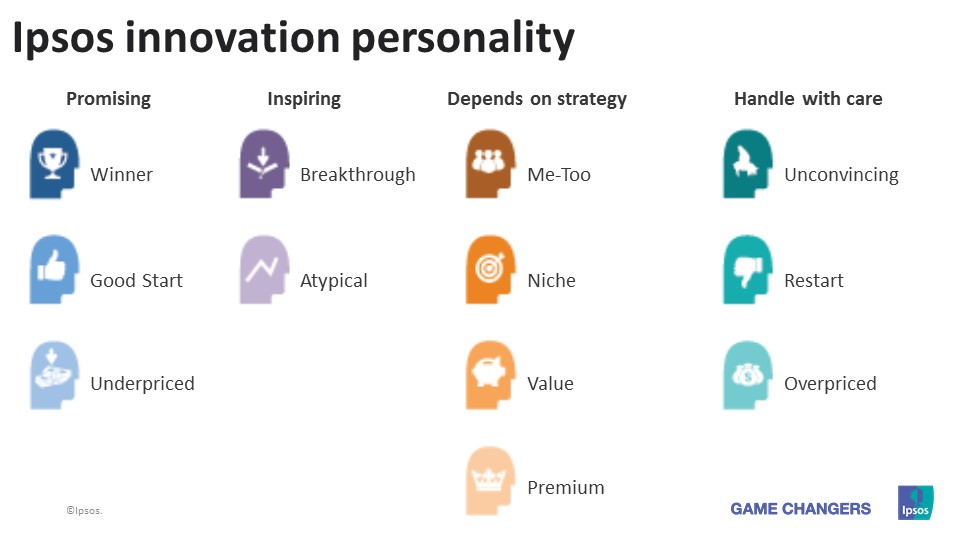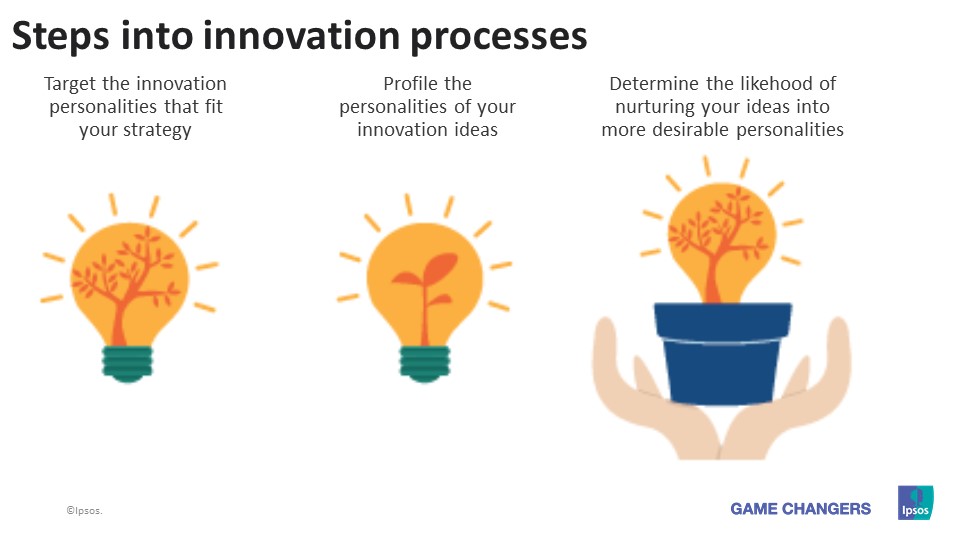Nature VS. Nurture - Can You Change Your Innovation’s Destiny?
Every innovation has its own personality
Examples of innovation personalities are:
- Winner (likely a big hit)
- Breakthrough (can create a new category but not necessarily a winner yet)
- Me-Too (which is a close-in line extension)
- Niche (appeals only to a certain segment)
Does your innovation have the right personality?
What we have found is that some personalities have a better chance of success than others.
Through a unique algorithm using key performance indicators, we have identified 12 personalities that an innovation might possess. We then grouped them in terms of market potential or strategy.

We categorize the first group of personalities as “Promising.”
Promising personalities include Winners, Good Starts, and Underpriced. Winners score well on all metrics. Good Starts do not perform as well but have no weaknesses. Underpriced are perceived as not expensive and can command a higher price.
We categorize the next group of personalities as “Inspiring.”
Inspiring personalities include Breakthroughs, which might be highly appealing but are not yet believable enough to succeed in the market.
Then there is a group of personalities whose success depends on the marketer’s strategy – hence the name “Depends on Strategy.”
This group includes Me-Too, Niche, Value and Premium personalities. A marketer might want a Premium personality on the high end of the market (Lindt is an example in the chocolate category) or a marketer might want to go after a Niche personality (Kinder Surprise, the chocolate candy with the toy inside, is example of an innovation in the chocolate category targeting households with young children).
Finally, there is a group of personalities with a much lower chance of success that we call “Handle with Care”.
For example, an Unconvincing personality is unique, but does not really fulfill a need; moreover consumers are not sure these innovations will deliver on their promise.
As you can see, innovations don’t always have the personalities we want. The question is: Will nature prevail and it will be difficult to change our innovation’s personality? Or, do marketers have the power to nurture an innovation into a higher potential opportunity that aligns with his or her strategy?
Our investigation: is personality change possible?
To determine if personality change is possible, we tracked innovation personalities from idea testing to concept testing.
We identified the personalities at the idea stage, decided which ones we wanted to change, and then looked to see if these personalities changed at the concept stage.
By idea we mean a single statement that defines the innovation. For example: A dishwasher detergent that cleans your dishes and dishwasher at the same time.
The concept is the next stage in the innovation process. Our clients typically test single statement ideas first and then develop them into concepts. The concept is a more complete description with marketing elements such as branding, price, and reasons to believe.
We think of the idea as Nature and the Concept as Nurture. What we are comparing is the single statement idea that marketing has not touched yet to the concept which has been enhanced by marketing.
When testing ideas which are unpriced, we have 8 idea personalities.
8 idea personalities: Winner, Good Start, Breakthrough, Atypical, Me-Too, Niche, Unconvincing and Restart
When testing concepts which are priced, we have the 8 idea personalities plus an additional 4 personalities that take into account Expensiveness, which measures how expensive consumers perceive the innovation to be versus competition.
12 concept personalities: Winner, Good Start, Breakthrough, Atypical, Me-Too, Niche, Unconvincing and Restart plus Underpriced, Value, Premium, and Overpriced.
Implications
The two case studies presented in the whitepaper reveal several interesting realities.
First, marketers may start with a different mix of personalities and these personalities may not align with their strategy, as was with the case with the two clients we just saw. Second, marketers differ in their commitment and ability to nurture certain types of innovation personalities. Third, generally speaking, marketers have more success nurturing some personalities than others.
In practical terms, Breakthrough ideas can be nurtured into Good Starts or Winners when messaging addresses Believability concerns. Me-Too ideas also can be nurtured into Good Starts or Winners by focusing on differentiating selling points. And Unconvincing ideas can be nurtured into Breakthroughs by making a strong case to consumers why they need this innovation.
Moving forward, we recommend that marketers incorporate the following steps into their innovation processes:

Finally, let’s go back and address the nature vs. nurture debate, specifically: does nature or nurture drive an innovation’s destiny?
Based on our case studies and experience with innovation personalities, both nature and nurture are important in driving your innovation’s destiny.

![[WEBINAR] Ipsos@Cannes 2025 - The Empathy Re-Connection](/sites/default/files/styles/list_item_image/public/ct/event/2025-09/Cannes_1.jpg?itok=1BV8OhRD)

